In a crowded market, where customers have many options, localizing products is crucial for companies to survive. Brands that put their customers first by leveraging localization are more likely to succeed than those that don't. But multilingual localization isn't a one-and-done deal, it hasn't escaped the changes that have rocked businesses everywhere, such as changing economies, new technology, and the ever-evolving function of marketing and content in people's lives. The objective of accurate localization is almost always unclear and challenging for many businesses.
In this article, we'll delve into the intricacies of multilingual localization, particularly in the digital and software realms, and examine how LAT Multilingual and Mind Studios approach these challenges.
Highlights:
Significance of localization ROI: DeepL's 2024 report reveals a staggering 96% positive ROI from localization efforts, underscoring its role in enhancing user experience and global market connection. Of these, 65% achieved a threefold or higher return.
Contextual Adaptation's Power: Beyond translation, localization adapts content, imagery, and design to resonate culturally, ensuring relatability and engagement, which is vital for navigating international market complexities and fostering user satisfaction.
Strategic localization planning: A robust multilingual content strategy involves thorough market research, creative adaptation, and technology utilization, which is essential for reaching diverse audiences effectively while maintaining cultural relevance and brand integrity.
What is multilingual localization?
But what is multilingual localization? Essentially, it creates multilingual content marketing. This strategy involves creating, translating, and distributing marketing content in multiple languages to reach a wider global audience. However, when it comes to localizing products for international companies, it is critical for worldwide market expansion since it improves the user experience and builds a stronger connection with local audiences. According to Nimdzi, nine out of ten individuals prefer products that are available in their native language, emphasizing the importance of content localization in reaching clients worldwide in their chosen language.
Likewise, the 2024 DeepL report highlights that localization efforts deliver significant returns, with 96% having a positive ROI and 65% obtaining an ROI of three times or higher. Successful companies prioritize localization to enhance user experience and connect with diverse audiences worldwide.
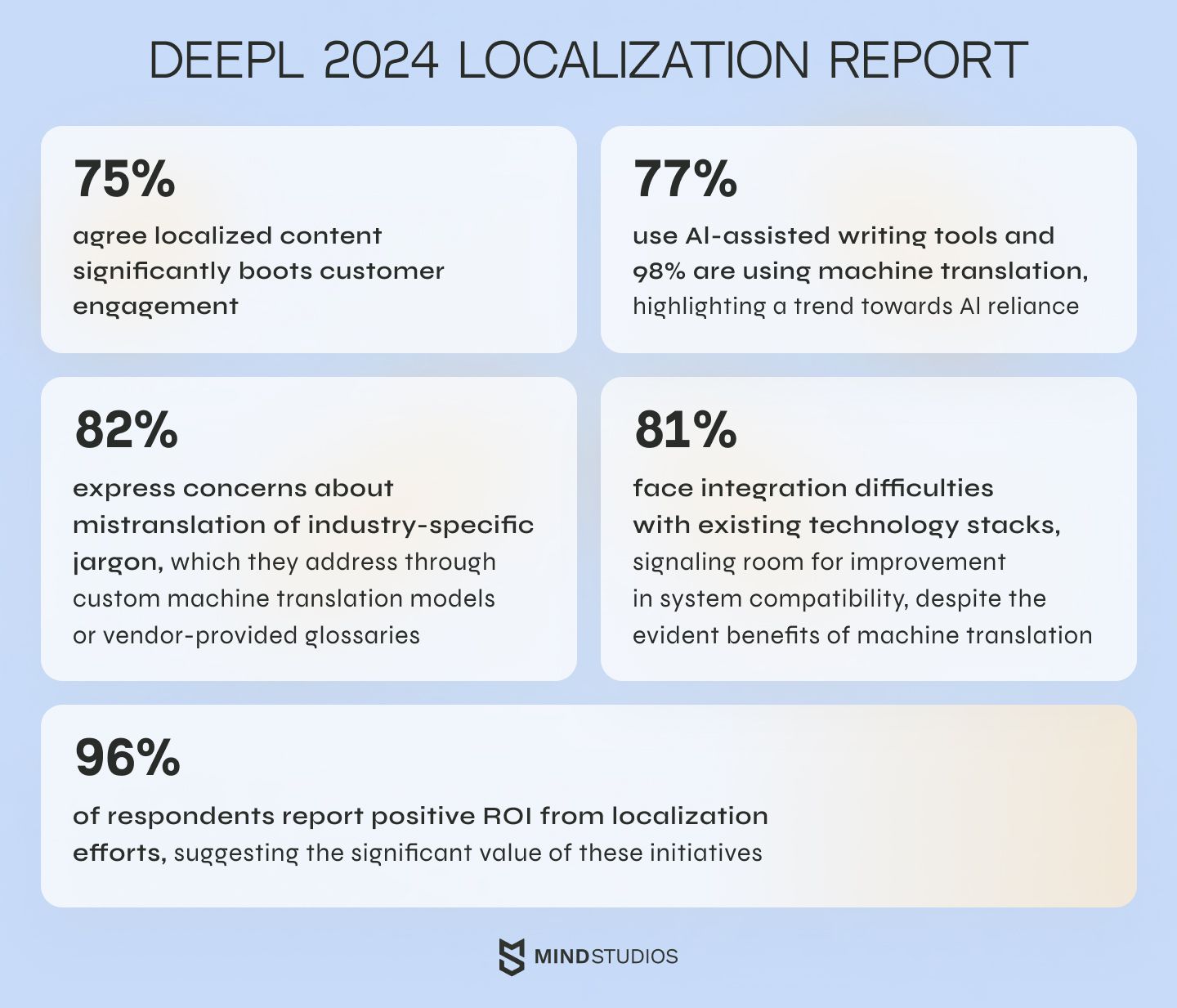
Source: DeepL
Potential localization challenges and how to overcome them
Businesses expanding internationally often face cultural differences that affect communication and user experience. Cultural customs, values, and preferences affect how people view and use products and services. Colors, symbols, and positive phrases in one culture may be negative or confusing in another. Understanding these cultural differences is essential for a good user experience.
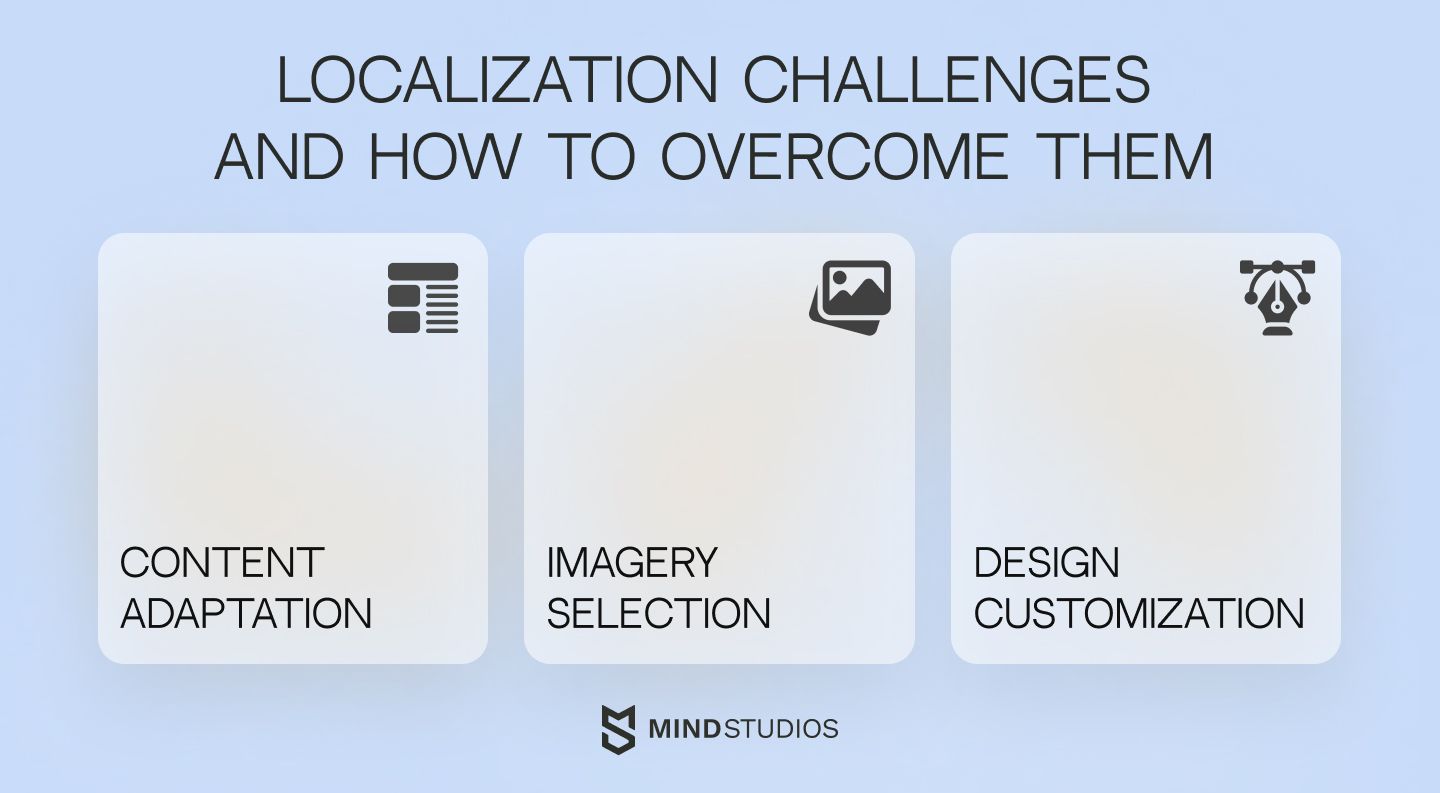
Localization plays a vital role in navigating these complexities. It goes beyond simple translation to adapt content, imagery, and design in ways that resonate with local audiences. Here’s how it works:
-
Content adaptation: Localization ensures that the language used in marketing materials, websites, and product information is accurate and culturally appropriate. This involves using idioms, humor, and references familiar to the local audience, making the content more relatable and engaging.
For example, the English idiom "it's raining cats and dogs" if translated word-for-word, would be confusing in a different country.
China is well-known for its idioms and savvy words. The phrase "马马虎虎" "mǎ mǎ hū hū" literally translates to “horse horse tiger tiger”. However, if you localize it properly into English, you’ll get "run of the mill."
When translated into another language, such idioms might produce hilarious misinterpretations.
-
Imagery selection: Images and graphics are powerful communication tools but can be interpreted differently across cultures. For instance, a thumbs-up gesture is a positive sign in many countries but can be offensive to others in Afghanistan, Iran, parts of Italy, and Greece. Localization involves choosing images that align with local cultural norms and values, avoiding potential misunderstandings.
-
Design customization: A product or website's visual design can significantly affect user experience. Localization adapts design elements — layout, color schemes, and icons — to fit local preferences. For example, while a minimalistic design might appeal to users in one country, a more vibrant and detailed design might be preferred in another.
Language barriers can lead to misunderstandings, reduced production, and missed international communication opportunities. Technical issues like date formats and legal requirements may vary regionally. Localization preserves tone and meaning while improving comprehension and engagement by adapting content to the target audience's language and culture.
Brand integrity and customer confidence depend on accurate localization, which ensures clear, culturally relevant communication across languages. Localization improves communication, acceptability, and international partnerships, helping companies succeed in multiple markets.
How to create a multilingual content strategy?
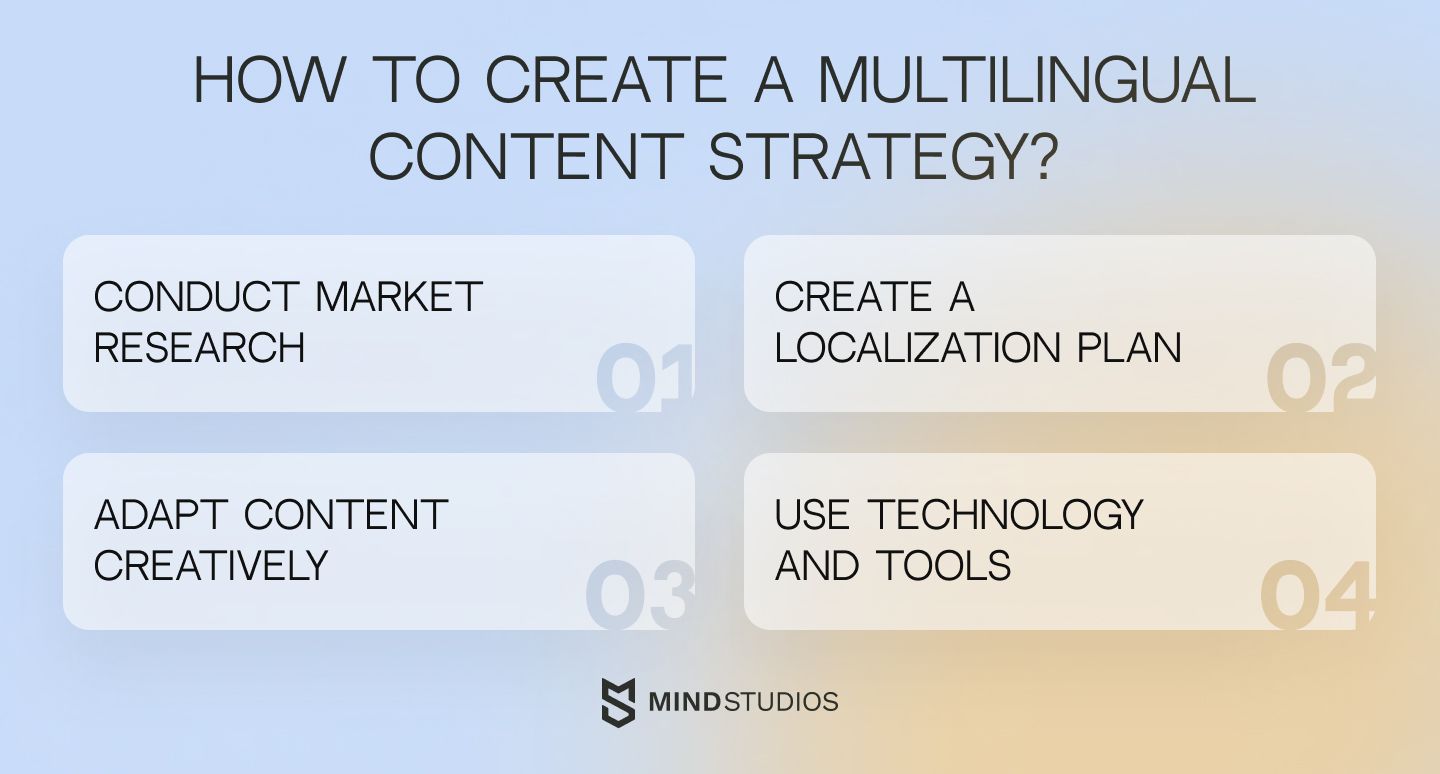
If you are considering entering new markets, employing localization professionals is one of the most sensible steps to take. And if you're unsure of where to start looking for those professionals, here's our recommendation: our partners, LAT Multilingual, offer translation and transcreation services in various languages and can help you develop a working localization strategy. Check them out to see if they'll fit your requirements (we believe they will!).
For those of our readers who would like to go into the localization processes extensively prepared, below are the basic steps to create a multilingual content localization strategy when expanding into new areas:
Conduct market research
Start by thoroughly understanding your target markets' local culture, language nuances, and consumer behavior. Together with LAT Multilingual, we recommend studying local customs, popular trends, and social norms that can influence how your multilingual content is received. Proper research ensures that your marketing messages are relevant and resonate with the local audience.
Create a localization plan
Set goals, target languages, and content types like websites, ads, and social media posts to localize. We usually recommend identifying and prioritizing key markets by business goals and ROI. A clear plan guides resource allocation.
Adapt content creatively
Consider creatively adapting marketing messages, visuals, and designs to local tastes and customs instead of just translating them. Local idioms, humor, and references make content more engaging. This method ensures that target audiences connect with your marketing.
Use technology and tools
According to Contentoo's 2024 localization report, some brands feel that localization is essential, with 70% of them using machine translation. However, quality is a significant challenge because AI typically struggles with recognizing nuance, resulting in low adoption. Adoption may also be low because most companies consider adopting machine learning a big investment. Despite this, the language translation market is estimated to grow at a rate of 12.40% per year, reaching 11.94 billion USD in 2030.
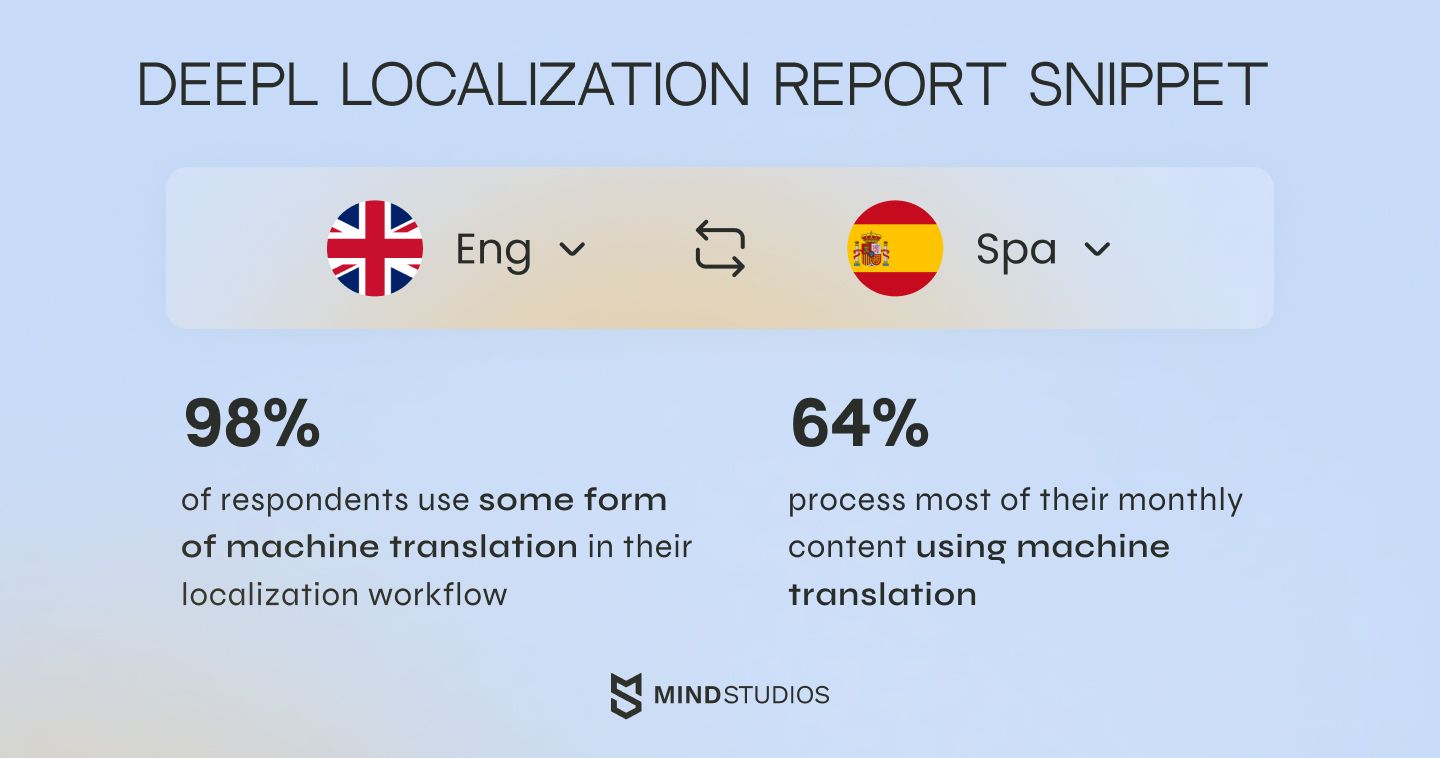
Source: DeepL
Improving translation and localization efforts is crucial, and we advise leveraging translation management systems (TMS) and other localization tools to streamline the localization process, maintain consistency, and enhance efficiency. These tools can automate workflows, manage terminology, and ensure your brand voice is consistent across all languages. Utilizing technology helps save time and resources while improving the quality of your localized content, as long as the process is supervised by localization experts.
By following these steps, businesses can create localized content that engages diverse audiences, builds trust, and drives international growth. This comprehensive approach ensures that your marketing efforts are culturally relevant and impactful in every market you enter.
Mind Studios as your software development partner

We have covered that localization is more than simply translation; it is also about adjusting your content, visuals, and design to reflect local customs and preferences. But what about developing your product? Localization would be incomplete without a product that works without a hitch, and Mind Studios specializes in developing software that achieves exactly that. Our strategy guarantees that your brand retains its identity while becoming culturally relevant and appealing to global consumers.
Why choose Mind Studios?
Mind Studios has a strong track record in delivering high-quality, localized digital and software solutions. Some highlights include:
- Design excellence: We craft visually appealing and culturally relevant user interfaces.
- Development prowess: We build robust, adaptable software and apps that support multiple languages and regional preferences.
- Continuous localization: We incorporate localization experts in the development cycle to keep products updated and relevant.
Importance of localization at the start of the development process: Expert tips from Mind Studios
Localization is crucial for businesses aiming to reach a global audience. By considering localization at the beginning of the development, companies can ensure their products are accessible, culturally relevant, and user-friendly across different markets.
At Mind Studios, we believe this proactive approach saves time and resources, preventing costly redesigns and making it easier to enter new markets smoothly. Here are our recommendations if you want to integrate localization into your projects early:
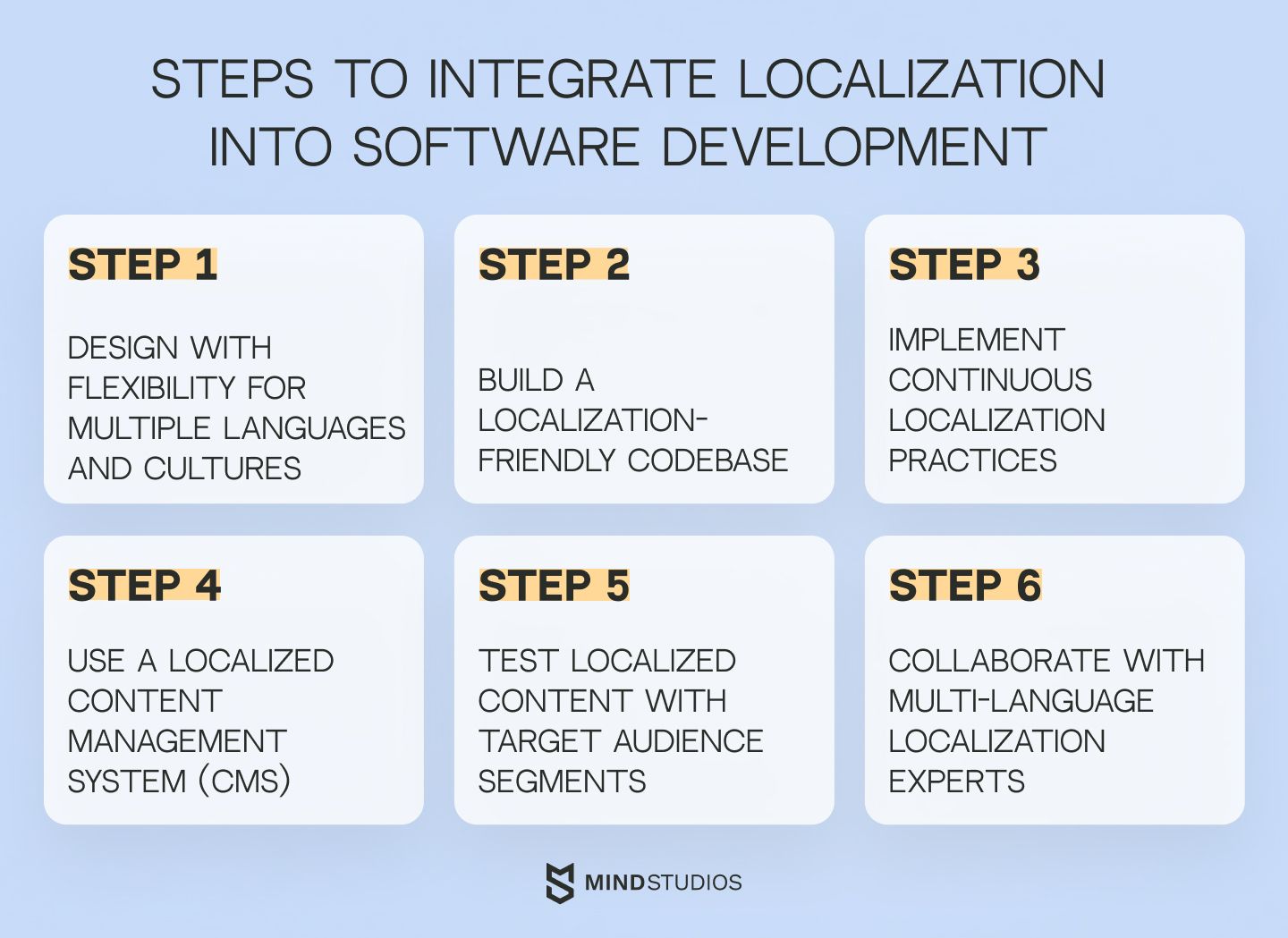
Tip 1: Design with flexibility for multiple languages and cultures
Contextual factors must be considered when you design software that accommodates multiple languages and cultural contexts from the outset. For example, different languages may require different amount of the screen or page space to display properly. When localizing alphabetic languages (e.g. English) into logographic ones (e.g. Chinese Mandarin), the space necessary for the same phrase will be different since logographic languages often pack a whole word into a single symbol.
As a result, when developing digital and software products, it is preferable to test the design following localization preferences. You need to use adaptable layouts to handle text expansion or contraction and consider cultural preferences in color schemes, images, and user interface elements. Flexible design ensures your product feels natural and intuitive to local users.
Tip 2: Build a localization-friendly codebase
Develop a codebase that supports localization by separating content from code. Use localization libraries and frameworks that allow easy content translation and localization adjustments without altering the core code. This practice simplifies updates and ensures consistency across different language versions of your software.
Tip 3: Implement continuous localization practices
Adopt continuous localization to keep your software updated and relevant. Integrate localization into your regular development cycle, allowing for ongoing updates and improvements as new features are added. This approach ensures that your product stays current and consistently meets the needs of global users.
Tip 4: Use a localized Content Management System (CMS)
Look for a CMS that can handle different languages and different regions. The localized material may be easily managed and updated this way, guaranteeing that it remains relevant and consistent throughout all markets.
Tip 5: Test localized content with target audience segments
Before fully launching your localized content, test it with a small segment of your target audience. This allows you to gather feedback and make any necessary adjustments. Testing helps identify any issues with language, design, or cultural appropriateness that might have been overlooked. Refining your content based on real user feedback ensures a smoother and more effective rollout.
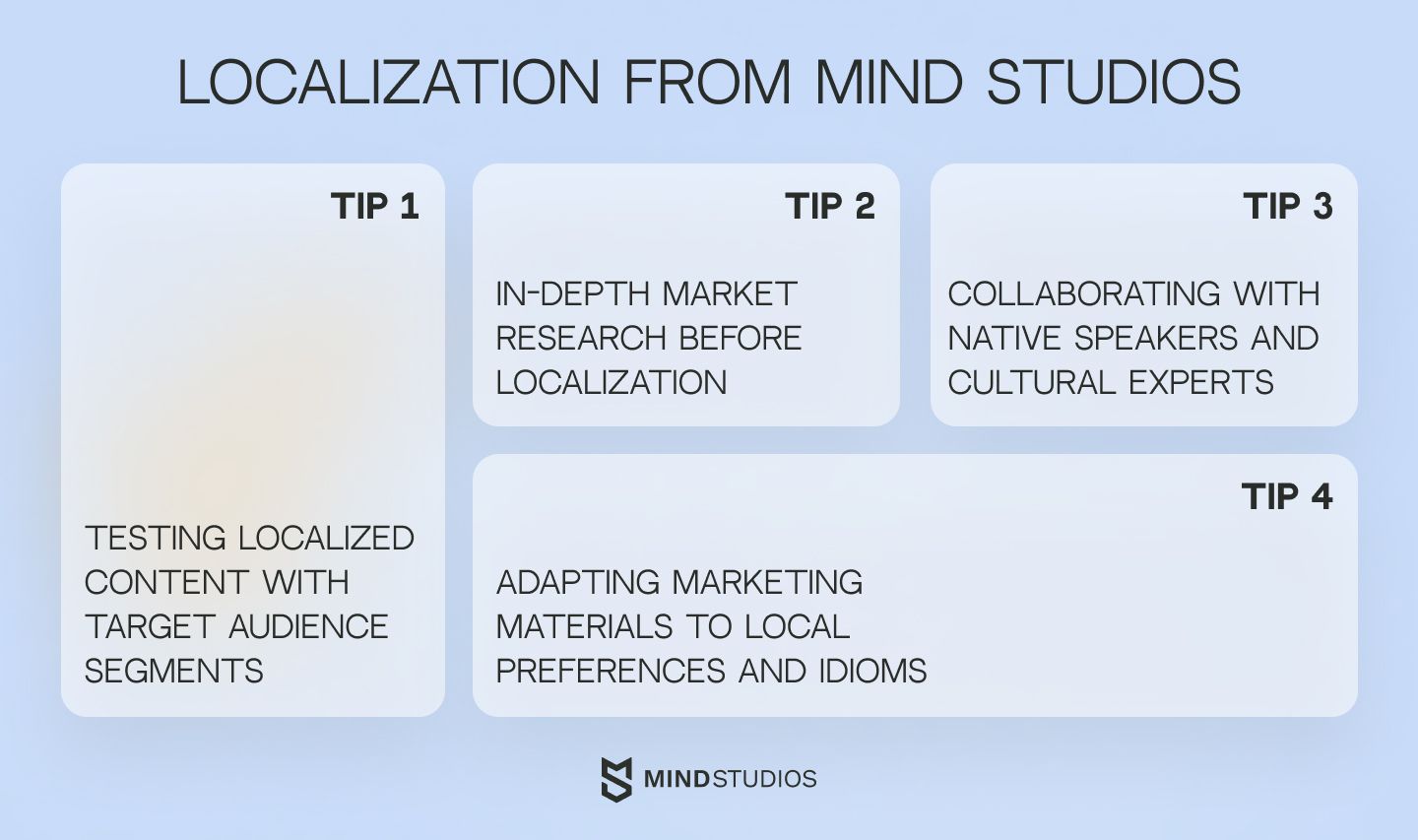
Tip 6: Collaborate with multi-language localization experts
Localization is more than just translating words; it's about connecting with people on a cultural level. That is why it is vital to turn to professionals to ensure the success of your marketing translation and localization efforts. Mind Studios’ partners, LAT Multilingual, aim to help clients reach new markets like French Canadian and Chinese markets, among others. Their years of experience working with a wide range of languages and cultures have enabled them to become a one-stop shop for all cultural marketing requirements.
Importance of working with localization experts
Finding a reliable localization partner is difficult, but Mind Studios is pleased to collaborate with partners who help us adapt to different cultures and languages. For example, here’s what LAT Multilingual offers:
- Expertise: LAT Multilingual has specialized in cultural marketing and linguistic adaptation for over two decades.
- Cultural insight: LAT's native speakers and cultural experts ensure every piece of content resonates with the target audience. From adaptation for French Canada and Québec, to campaigns on Chinese Canadians’ favorite platforms, they can help you connect with Canada’s diverse audiences and beyond.
- Language proficiency: LAT excels at linguistic adaptation, conveying idioms, humor, and other contextual nuances beyond translation to convey the right tone and message across cultural boundaries.
- Market research: LAT studies local customs, trends, and consumer behavior, guaranteeing accurate and effective marketing strategies.
By following these steps, businesses can create software that resonates with users worldwide, enhancing user experience and fostering greater engagement across diverse markets.
Cultural missteps and their consequences
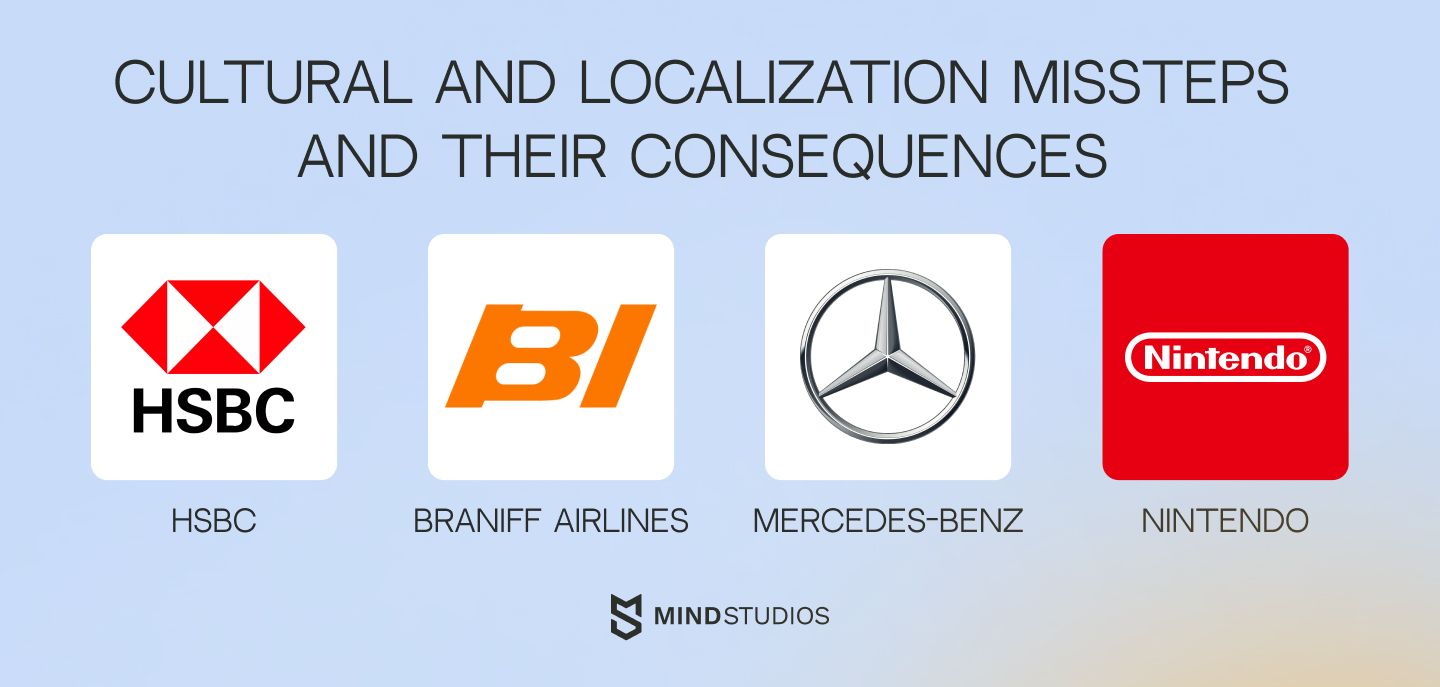
Unsurprisingly, cultural differences make it tough for businesses to succeed globally. Disregarding these differences can result in mistakes, damaged reputations, and missed opportunities. Even when big companies enter new markets, they do not necessarily succeed. Understanding the local culture, including what consumers want to buy and why, is critical to successfully competing in new markets.
These case studies show examples of cultural missteps by companies and the consequences they faced. By looking at these examples, we can learn more about the significance of good localization and its critical role in ensuring that messages and products connect with different audiences.
HSBC’s assume nothing campaign
HSBC's global campaign catchphrase, "Assume Nothing," was translated into "Do Nothing" in several countries, which has an entirely different meaning. It cost the bank millions to rebrand and get the translations right so that the campaign could reach its target audience.
Braniff Airlines’ leather seats campaign in Mexico
The slogan "Fly in Leather" for Braniff Airlines was translated as "Vuela en Cuero" in Spanish. In some Spanish-speaking regions, "en cuero" translates to "naked." This resulted in a mistaken and funny reading of the motto. The airline had to alter the translation swiftly.
Mercedes-Benz name in China
Mercedes-Benz initially entered the Chinese market under the name "Bensi," which translates as "Rush to Die" in Chinese. Recognizing the negative connotation, the company relaunched as "Benchi," which means "Run Quickly as Flying," to reflect the brand's luxury image better.
Nintendo’s limited language availability
Pikachu was renamed in May 2016, and about twenty protesters gathered outside the Consulate-General of Japan in Hong Kong to voice their opposition to the change. People from Taiwan speak Mandarin with a very different accent from Mainland China, while Hong Kongers speak Cantonese. Hong Kong and Taiwan use traditional characters, whereas Mainland China uses simplified characters. Nintendo's single Pokémon Sun & Moon localization gave Hong Kongers a product they would find hard to use. Despite the advantages of a uniform Chinese localization for developers, the players had difficulties with changes to the game's names and terminology.
By paying attention to these cultural aspects, businesses can create products and services that feel familiar and comfortable to users worldwide. This enhances user satisfaction, builds trust, and increases the likelihood of success in international markets. In short, good localization helps businesses connect with their global audience on a deeper, more meaningful level.
Case studies of successful software localization projects by Mind Studios
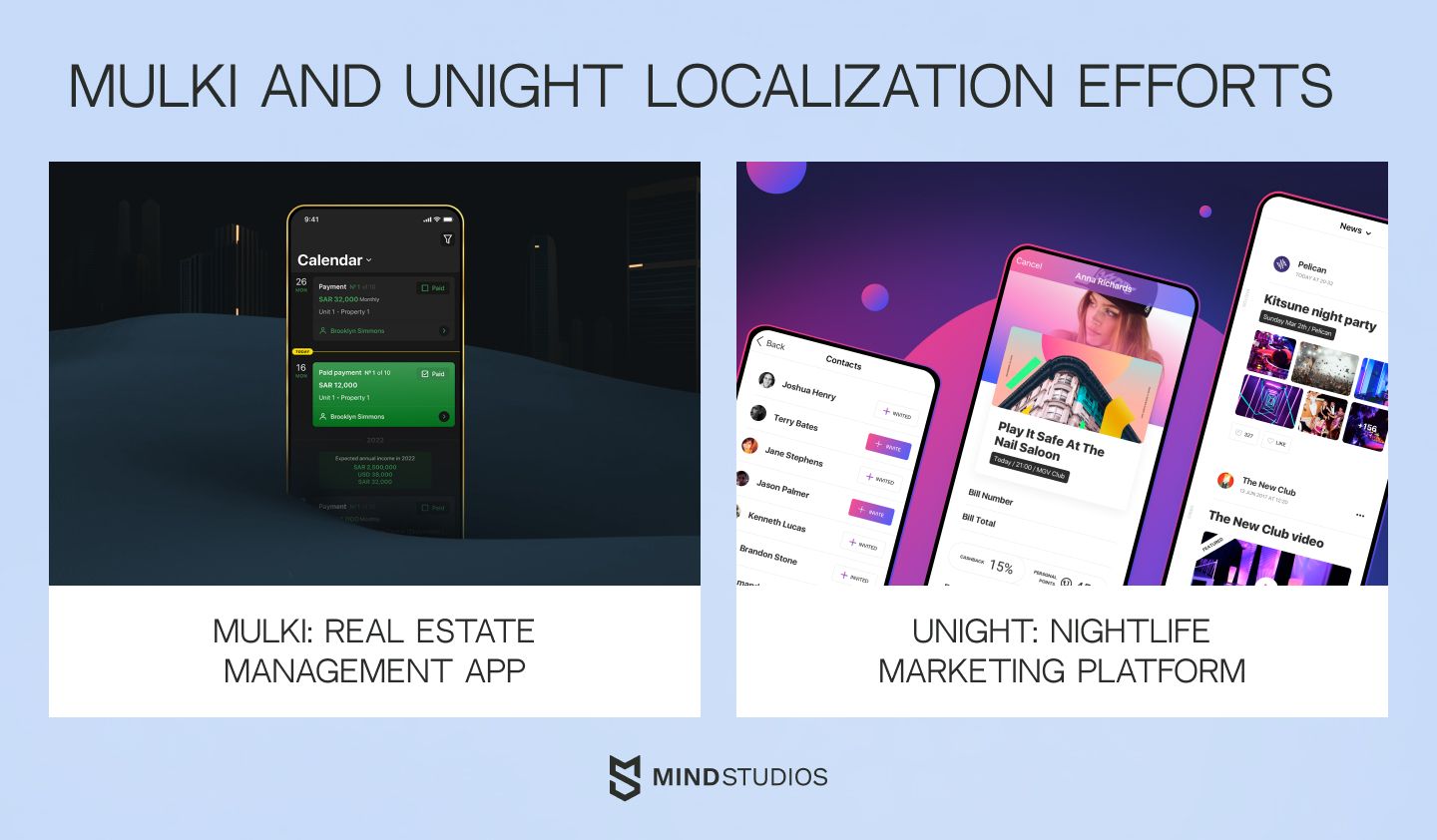
Localization enhances user engagement by tailoring products to match language and cultural preferences. Mind Studios has extensive experience in managing localization challenges, as demonstrated by the following projects:
Mulki property management app
Mulki, a property management app for the MENA region, helps real estate owners automate daily tasks. The app required thorough research to meet regional needs, including features like financial overviews, contract scanning, and payment reminders. The app also performs calculations for the Islamic Hijri calendar.
The main localization challenge was supporting the Arabic language and its right-to-left writing system. Mind Studios developed a mirrored interface for Arabic users. On top of the UI elements being mirrored, designers, developers, and the localization worked together on delivering the experience that not only looks appealing to the users but also resonates with the local culture and customs, which is highly important for a real-estate platform.
Unight nightlife social platform
Unight connects users to dining and entertainment venues in Shanghai, and it required deep localization. While working on Unight, both localization and design teams collaborated tightly to deliver a top-notch UI experience in 3 languages. Here are the results of this collaboration:
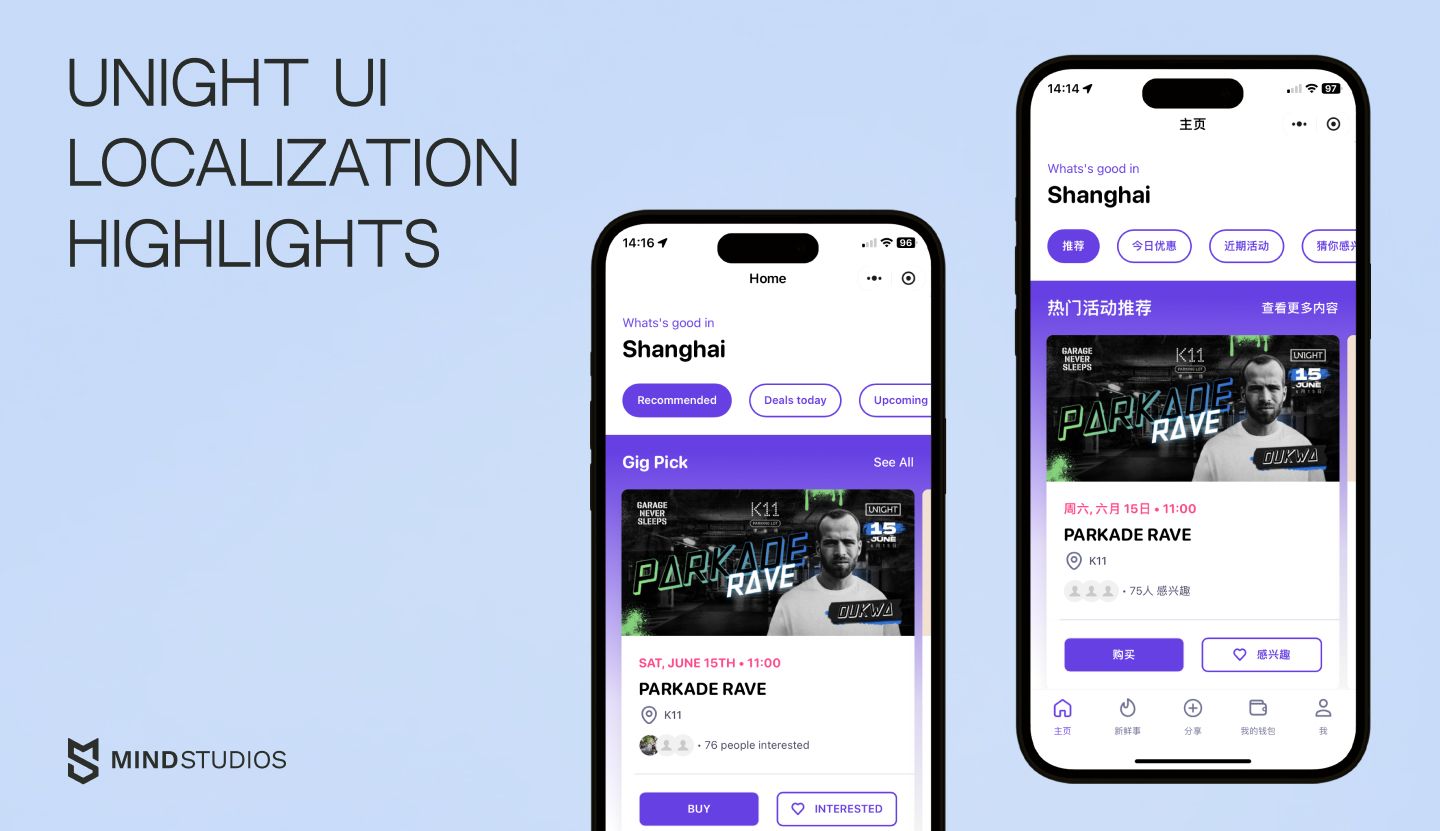
As you can see, localization extends beyond translation to include local cuisine preferences, dining habits, and payment solutions. Mind Studios aligns client requirements with market expectations and technical advancements, as seen in the Mulki and Unight projects, driving innovative solutions in the translation and localization industry.
Final thoughts
There is no denying that personalization is becoming an important part of competition in many industries. Localization substantially overlaps with and improves on most principles of content personalization. Hence, localizing your content for international markets and even smaller demographic segments within the regions you already operate in can be an excellent strategy to keep your brand competitive and growing for years.
If you have unique tech challenges with localization you need to address, or growth prospects you want to pursue, don't hesitate to request a free consultation. Our business development team is always available to assist you in finding the ideal digital strategy that meets your needs perfectly.



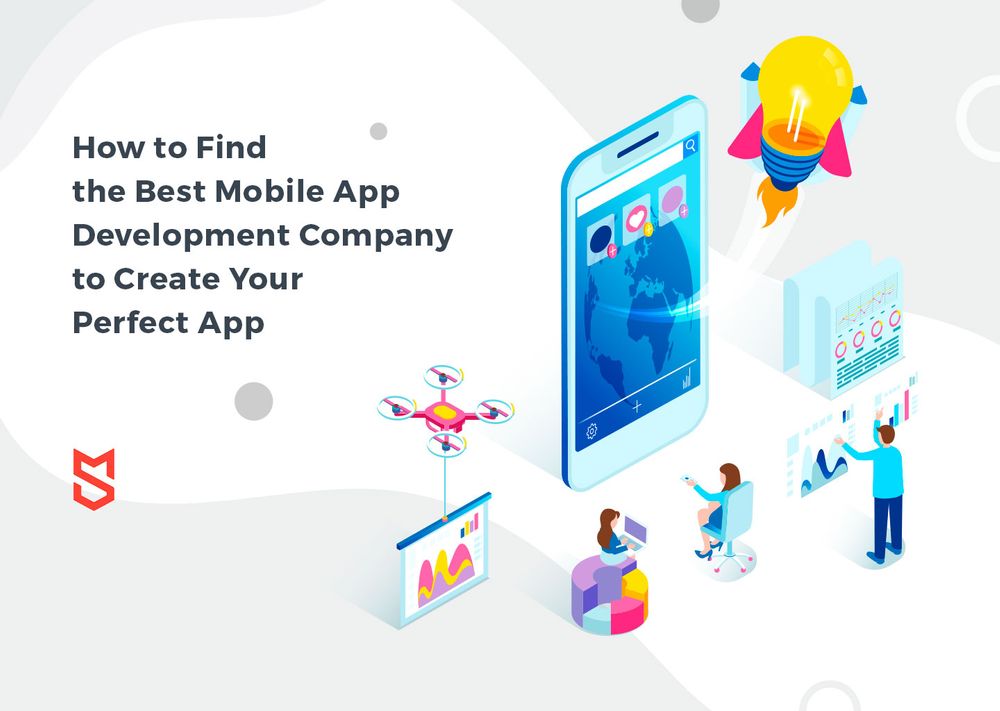
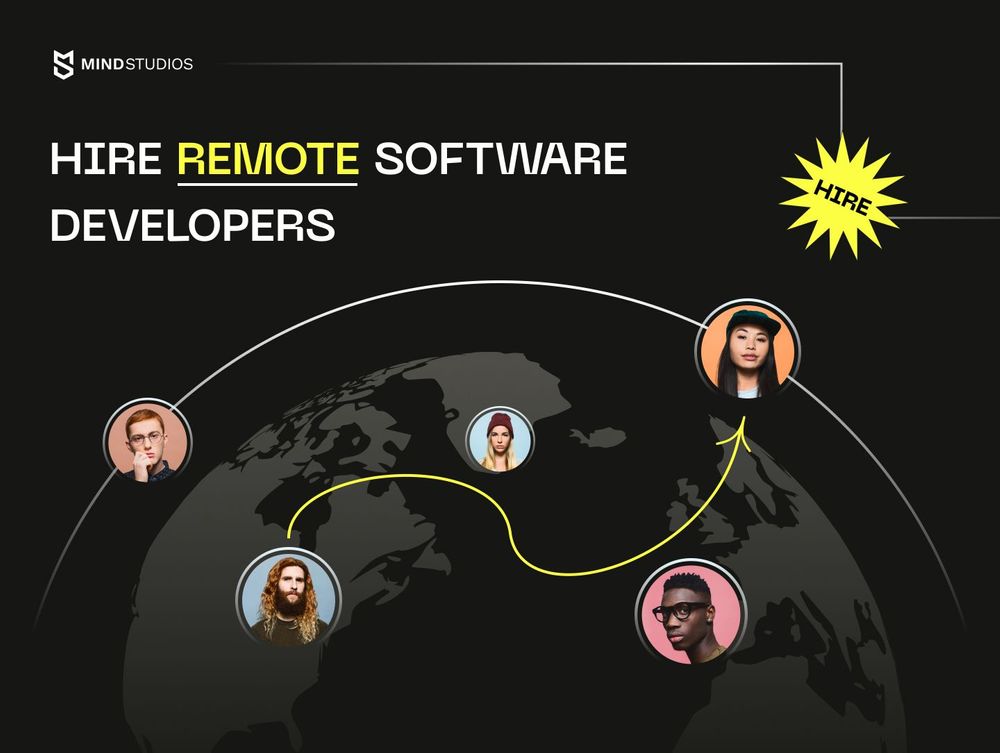



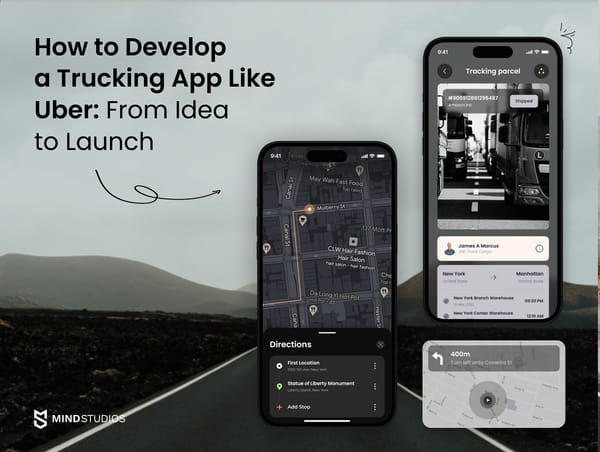
![How to Create an On-Demand Medicine Delivery App [Expert Guide]](https://themindstudios.com/blog/content/images/size/w600/2025/03/IMG-1-Cover-6.jpg)

